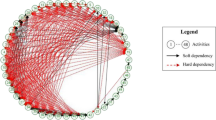Abstract
Resource allocation is an essential aspect of successful Product Development (PD). In this paper, we formulate the dynamic resource allocation problem of the PD process as a convex optimization problem. Specially, we build and solve two variants of this problem: the budget-constrained problem and the performance-constrained problem. We use convex optimization as a framework to optimally solve large problem instances at a relatively small computational cost. The solutions to both problems exhibit similar trends regarding resource allocation decisions and performance evolution. Furthermore, we show that the product architecture affects resource allocation, which in turn affects the performance of the PD process. By introducing centrality metrics for measuring the location of the modules and design rules within the product architecture, we find that resource allocation decisions correlate to their metrics. These results provide simple, but powerful, managerial guidelines for efficiently designing and managing the PD process. Finally, for validating the model and its results, we introduce and solve two design case studies for a mechanical manipulator and for an automotive appearance design process.
















Similar content being viewed by others
Notes
Product architecture is not the only driver for resource allocation decisions. Other drivers, such as existing product lineup, competitive products, product demand and price, technological advancements, consumer taste changes, balancing the development portfolio, etc., may play an influential role Terwiesch and Ulrich (2008). However, we focus on product architecture since it is the central issue in our proposed model.
See (Reich and Levy 2004, Sect. 4) for a related discussion on convex optimization in the context of engineering design.
References
Ahmad RA, Yassine A (2018) Experimenting with the NK and DSM models. In International dependency and structure modeling (DSM) conference. The 20th international DSM conference, pp. 47-57
Alcaraz J, Maroto C, Ruiz R (2003) Solving the multi-mode resource-constrained project scheduling problem with genetic algorithms. J Oper Res Soc 54(6):614–626
Baldwin CY, Clark KB (2000) Design rules. The MIT Press, Cambridge
Barabási AL, Albert R (1999) Emergence of scaling in random networks. Science 286(5439):509–512
Batallas D, Yassine A (2006) Information leaders in product development organizational networks: social network analysis of the design structure matrix. IEEE Trans Eng Manag 43(4):570–582
Benesty J, Chen J, Huang Y, Cohen I (2009) Pearson correlation coefficient. Springer, Berlin
Boctor FF (1996) A new and efficient heuristic for scheduling projects with resource restrictions and multiple execution modes. Eur J Oper Res 90(2):349–361
Boyd S, Vandenberghe L (2004) Convex optimization. Cambridge University Press, Cambridge
Boyd S, Kim SJ, Vandenberghe L, Hassibi A (2007) A tutorial on geometric programming. Optim Eng 8(1):67–127
Braha D, Bar-Yam Y (2004a) Information flow structure in large-scale product development organizational networks. J Inf Technol 19(4):244–253
Braha D, Bar-Yam Y (2004b) Topology of large-scale engineering problem-solving networks. Phys Rev E 69(1):016113
Braha D, Bar-Yam Y (2007) The statistical mechanics of complex product development: empirical and analytical results. Manag Sci 53(7):1127–1145
Christensen CM (2002) Disruption, disintegration and the dissipation of differentiability. Ind Corp Change 11(5):955–993
Collins S, Yassine A, Borgatti S (2009) Evaluating product development systems using network analysis. Syst Eng J 12(1):55–68
Erdös P, Rényi A (1959) On random graphs I. Publ Math Debr 6:290–297
Frenken K, Mendritzki S (2012) Optimal modularity: a demonstration of the evolutionary advantage of modular architectures. J Evol Econ 22(5):935–956
George P, Remon P, Ahmad B (2012) Development of a DSM-based methodology in an academic setting. ASME J Mech Des 134(2):021007
Joglekar NR, Yassine A, Eppinger SD, Whitney DE (2001) Performance of coupled product development activities with a deadline. Manag Sci 47(12):1605–1620
Luo J (2015) A simulation-based method to evaluate the impact of product architecture on product evolvability. Res Eng Des 26(4):355–371
Maier JF, Wynn DC, Biedermann W, Lindemann U, Clarkson PJ (2014) Simulating progressive iteration, rework and change propagation to prioritise design tasks. Res Eng Des 25(4):283–307
Newman M (2010) Networks. Oxford University Press, Oxford
Ogura M, Harada J, Kishida M, Yassine A (2019) Resource optimization of product development projects with time-varying dependency structure. Res Eng Des 30(3):435–452
Ogura M, Kishida M, Lam J (2020) Geometric programming for optimal positive linear systems. IEEE Trans Autom Control. https://doi.org/10.1109/TAC.2019.2960697
Reich Y, Levy E (2004) Managing product design quality under resource constraints. Int J Prod Res 42(13):2555–2572
Rivkin JW, Siggelkow M (2007) Patterned interactions in complex systems: implications for exploration. Manag Sci 53(7):1068–1085
Smith RP, Eppinger SD (1997) Identifying controlling features of engineering design iteration. Manag Sci 43(3):276–293
Sosa M, Mihm J, Browning T (2011) Degree distribution and quality in complex engineered systems. J Mech Des 133(10):101008
Stellman A, Creene J (2005) Applied software project management. O’Reilly Media, Sebastopol
Tabachnick BG, Fidell LS (2007) Experimental designs using ANOVA. Duxbury
Terwiesch C, Ulrich K (2008) Managing the opportunity portfolio. Res Technol Manag 51(5):27–38
Ulrich K (1995) The role of product architecture in the manufacturing firm. Res Policy 24(3):419–440
Ulrich K (2008) Product design and development, 4th edn. McGraw-Hill, New York
Ulrich KT, Eppinger SD (2008) Collective dynamics of small-world’ networks. Nature 393(6684):440–442
Yassine A (2019) Managing the development of complex product systems: an integrative literature review. IEEE Trans Eng Manag 1:18
Yassine A, Naoum-Sawaya J (2016) Architecture, performance, and investment in product development networks. J Mech Des 139(1):011101
Yassine A, Wissmann LA (2007) The implications of product architecture on the firm. Syst Eng 10(2):118–137
Yassine A, Joglekar N, Braha D, Eppinger S, Whitney D (2003) Information hiding in product development: the design churn effect. Res Eng Des 14(3):145–161
Yu TL, Yassine A, Goldberg DE (2007) An information theoretic method for developing modular architectures using genetic algorithms. Res Eng Des 18(2):91–109
Author information
Authors and Affiliations
Corresponding author
Additional information
Publisher's Note
Springer Nature remains neutral with regard to jurisdictional claims in published maps and institutional affiliations.
Appendix
Appendix
In this appendix, we illustrate how we can reduce Problems 1 and 2 to convex optimization problems. We introduce the following notations for cost functions. For the total cost function in (3), we define
Let us first show that Problem 1 reduces to solving a convex optimization problem. Notice that the optimization problem (4) is equivalent to
Under this notation, we can show that the solution of the budget-constrained problem is given by
where \(\exp [\cdot ]\) is the entrywise exponential function of the variables, and \(x=\{x_k\}^T_{k=1}\) and \(y=\{y_k\}^T_{k=1}\) solve the following convex optimization problem:
Let us give a brief proof of this statement. Under Lemma 1, it can easily be seen that (7a), (7b), and (7d) in the budget-constrained problem are equivalent to (9b), (9c), (9d), and (9e). Therefore, the solution of the optimization problem (9) given by (8) is the solution of the budget-constrained problem. Under this equivalence, we show the convexity of the optimization problem (9). It is sufficient to show that constraints (9b) and (9c) are convex if the performance functions (7a), (7b) and the cost function (3) follow Definition 1.
We can similarly reduce Problem 2 to a convex optimization problem. We can specifically show that the solution of the performance-constrained problem is given by (8), where \(x=\{x_k\}^T_{k=1}\) and \(y=\{y_k\}^T_{k=1}\) solve the following convex optimization problem
We omit the proof of this statement because it is similar to the one for the budget-constrained problem.
Rights and permissions
About this article
Cite this article
Zhao, C., Ogura, M., Kishida, M. et al. Optimal resource allocation for dynamic product development process via convex optimization. Res Eng Design 32, 71–90 (2021). https://doi.org/10.1007/s00163-020-00346-5
Received:
Revised:
Accepted:
Published:
Issue Date:
DOI: https://doi.org/10.1007/s00163-020-00346-5




